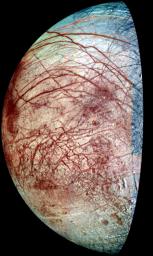
|
Europa’s Frozen Surface
- Click the image above for a larger view
- Full-Res JPEG (536 x 900) (111.1 kB)
- Full-Res TIFF (536 x 900) (1.3 MB)
Caption:
Europa, a moon of Jupiter, appears as a thick crescent in this enhanced-color image from NASA's Galileo spacecraft, which has been orbiting Jupiter since 1995.
The view combines images taken in violet, green and near-infrared filters in 1998 and 1995. The colors have been stretched to show the subtle differences in materials that cover the icy surface of Europa. Reddish linear features are some of the cracks and ridges, thousands of kilometers long, which are caused by the tides raised by the gravitational pull of Jupiter. Mottled, reddish "chaotic terrain" exists where the surface has been disrupted and ice blocks have moved around. The red material at the ridges and chaotic terrain is a non-ice contaminant and could be salts brought up from a possible ocean beneath Europa's frozen surface.
Also visible are a few circular features, which are small impact craters. Europa's surface has very few craters, indicating that recent or current geologic activity has removed the traces of older impacts. The paucity of craters, coupled with other evidence, has led scientists to surmise that there could be an ocean of liquid water beneath Europa's surface. Where there is water, there could be life. This is why Europa is a target of current interest for study of the possibility of non-Earth life. A follow-up spacecraft to Galileo will be Europa Orbiter, which should determine whether or not Europa has an ocean.
While at the University of Arizona, Tucson, Dr. Cynthia Phillips used this image in a detailed search for current geologic activity on Europa. Phillips is currently with the SETI Institute, Mountain View, Calif. For a study published in the Journal of Geophysical Research -- Planets last year, she compared the frames that make up this image with similar images taken in 1979 by the Voyager spacecraft and found no sign of changes due to geologic activity. That suggests a minimum surface age for Europa of about 30 million years, though the result does not rule out current geologic activity altogether, as the study was limited by the resolution of 2 kilometers (1.6 miles) or more per pixel in this image and the Voyager images. Future images by Europa Orbiter may allow a search for smaller-scale changes on Europa's surface.
Background Info:
The Jet Propulsion Laboratory, a division of the California Institute of Technology in Pasadena, manages the Galileo and Voyager missions for NASA's Office of Space Science, Washington, D.C. Additional information about Galileo and its discoveries is available on the Galileo mission home page at http://solarsystem.nasa.gov/galileo/ .
Cataloging Keywords:
| Name | Value | Additional Values |
|---|---|---|
| Target | Europa | Jupiter |
| System | Jupiter | |
| Target Type | Satellite | Planet |
| Mission | Galileo | Voyager |
| Instrument Host | Galileo Orbiter | |
| Host Type | Orbiter | Flyby Spacecraft |
| Instrument | Solid-State Imaging (SSI) | |
| Detector | ||
| Extra Keywords | Color, Crater, Impact, Infrared, Mountain, Water | |
| Acquisition Date | ||
| Release Date | 2001-06-22 | |
| Date in Caption | ||
| Image Credit | NASA/JPL/University of Arizona | |
| Source | photojournal.jpl.nasa.gov/catalog/PIA02590 | |
| Identifier | PIA02590 | |
